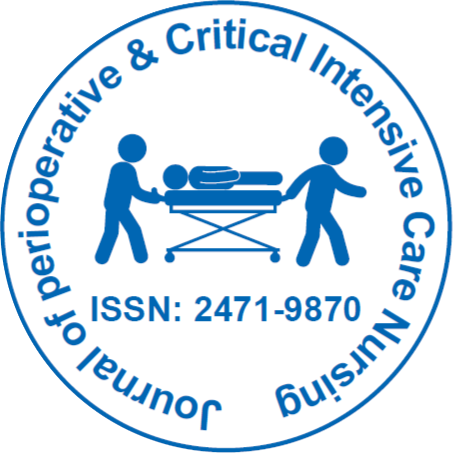
Journal of Perioperative & Critical Intensive Care Nursing
Open Access
ISSN: 2471-9870

ISSN: 2471-9870
Commentary - (2024)Volume 10, Issue 2
Intensive Care Units (ICUs) represent the pinnacle of healthcare's response to critically ill patients, providing specialized care that demands a unique blend of expertise, technology, and compassion. These units serve as the lifeline for patients facing severe medical crises, where timely interventions and meticulous monitoring can make the difference between life and death. This article discusses the multifaceted role of ICUs, highlighting their structure, challenges, innovations, and the important contributions of healthcare professionals, particularly critical care nurses. By encourage a supportive environment and advocating for patient needs, critical care nurses play a vital role in promoting positive outcomes and improving quality of life for critically ill individuals. Their dedication and expertise contribute significantly to the overall success of intensive care treatment strategies.
Structure and function of ICUs
ICUs are specialized units within hospitals designed to provide intensive treatment and monitoring for patients with life-threatening conditions. They typically feature advanced medical equipment, including ventilators, cardiac monitors, and renal replacement therapy machines, to support patients with compromised organ function. The layout of ICUs is optimized for continuous observation and immediate access to medical interventions, ensuring rapid response to changing patient needs. ICU teams are trained to handle emergencies and make critical decisions swiftly, often using protocols and guidelines to ensure consistent, high-quality care. The integration of advanced technology and continuous monitoring helps ICU staff anticipate and respond to changes in patient conditions proactively, thereby improving outcomes for critically ill individuals.
Multidisciplinary approach to care
Central to the success of ICUs is the collaboration among multidisciplinary teams comprising physicians, nurses, respiratory therapists, pharmacists, and other healthcare professionals. Each brings specialized knowledge and skills to the table, facilitating comprehensive assessment, treatment planning, and decision-making. Team-based care ensures that patients receive coordinated interventions customized to their individual conditions, thereby optimizing outcomes and minimizing complications.
Challenges in ICU care
Operating within ICUs presents a myriad of challenges for healthcare providers. High patient acuity, complex medical conditions, and the unpredictability of patient responses necessitate constant vigilance and adaptability. Critical care nurses, in particular, must navigate ethical dilemmas, such as end-of-life care decisions and family interactions during times of crisis. Additionally, the emotional toll of caring for critically ill patients can impact the well-being of healthcare professionals, highlighting the importance of support systems and self-care practices within ICU settings.
Innovations and technological advances
Advancements in medical technology play a pivotal role in enhancing care delivery within ICUs. Innovations such as remote monitoring systems, advanced imaging modalities, and point-of-care testing have revolutionized diagnostic accuracy and treatment efficacy. Similarly, the integration of Electronic Health Records (EHRs) facilitates seamless communication and data sharing among healthcare providers, promoting continuity of care and patient safety.
Patient-centered care in ICUs
Despite the clinical focus of ICUs, patient-centered care remains paramount. Critical care nurses and healthcare teams prioritize communication with patients and their families, ensuring transparency regarding treatment plans, prognosis, and potential outcomes. Shared decision-making and cultural sensitivity are integral components of patient care within ICUs, encouraging trust and collaboration among all stakeholders involved in the patient's journey. Through effective communication and empathy, critical care nurses ensure that patients and families feel informed and supported, even in the midst of challenging medical situations. This patient-centered approach underscores the importance of complete care in ICU settings.
Education and training in critical care
The complexity of ICU care underscores the importance of rigorous education and training for healthcare professionals. Many institutions offer specialized programs and certifications in critical care nursing and critical care medicine, equipping providers with advanced clinical skills, critical thinking abilities, and proficiency in managing emergent situations. Continuous professional development ensures that healthcare teams remain abreast of evolving practices and evidence-based guidelines in critical care. This commitment to education and training empowers healthcare professionals to adapt swiftly to new challenges and advancements in medical technology, ultimately improving outcomes and patient safety in intensive care environments.
Intensive Care Units represent a modern healthcare, providing essential support and advanced care for patients during their most vulnerable moments. Through a multidisciplinary approach, innovative technologies, and a commitment to patient-centered care, ICUs strive to achieve optimal outcomes while navigating complex medical challenges. As healthcare continues to evolve, ongoing research, education, and collaboration among healthcare professionals will further enhance the efficacy and quality of care delivered within ICUs, reaffirming their critical role in saving lives and improving patient outcomes.
Citation: Baran B (2024) Role of Intensive Care Units in Modern Healthcare: Educational Foundations and Professional Growth in ICU Settings. J Perioper Crit Intensive Care Nurs. 10:253.
Received: 10-May-2024, Manuscript No. JPCIC-24-32839; Editor assigned: 13-May-2024, Pre QC No. JPCIC-24-32839 (PQ); Reviewed: 27-May-2024, QC No. JPCIC-24-32839; Revised: 03-Jun-2024, Manuscript No. JPCIC-24-32839 (R); Published: 10-Jun-2024 , DOI: 10.35248/2471-9870.24.10.253
Copyright: © 2024 Baran B. This is an open-access article distributed under the terms of the Creative Commons Attribution License, which permits unrestricted use, distribution, and reproduction in any medium, provided the original author and source are credited.